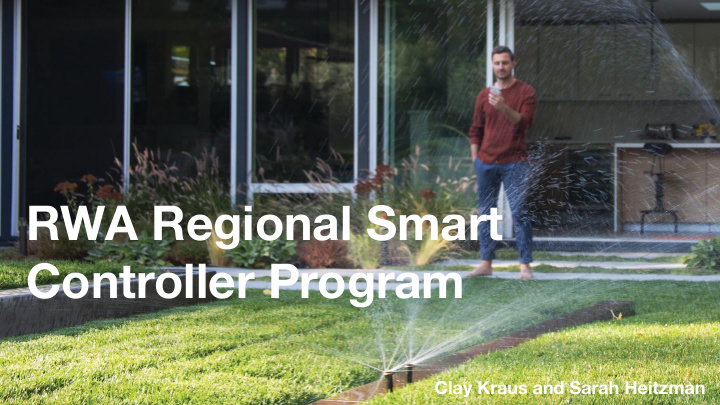



RWA Regional Smart Controller Program Clay Kraus and Sarah Heitzman
A company focused on taking the guesswork out of outdoor irrigation and water use.
A platform that provides water agencies with valuable insight into outdoor water use and landscape characteristics. CONFIDENTIAL CONFIDENTIAL
Tech-forward solutions create rational markets by helping utilities and customers alike manage to water budgets. Leak Detection and Flow Smart Irrigation Aerial Imagery and Satellite Advanced Weather Solutions 4 Source: Santa Margarita Water District
Case Studies
Spanish Fork (Utah) Problem: System capacity is a challenge for the City as a result of their fast-paced growth. High growth projections have led them to explore creative means of making the most of their existing infrastructure. High intra-day water use peaks (early morning and late evening) are exacerbated by windy conditions, reducing irrigation efficiency, and further contributing to capacity issues. Goal: Convert 1,000-1,250 households annually to the Rachio controller, and configure start times to alternate across the City, thus smoothing demand and reducing peak use. Results: 2,400 controllers installed, with average outdoor water savings of 17%. Peak reduction is estimated to reach 9% should the program scale to 10,000 controllers. Credit: Brigham Young University
Woodbury (Minnesota) Problem: The City has a limited water supply, and many of their wells produce low quality water. It is cost prohibitive for them to develop new, clean sources of supply. Goal: The City has created a “Flat Water Use by 2030” goal to preserve their limited supply, avoid developing new sources, and limit pumping from contaminated sources. Approximately 900 Rachio controllers are distributed annually to help improve outdoor efficiency. Results: 2,000 controllers installed, with an average outdoor water savings of 49%. At full implementation, Rachio controllers will be installed in 50% of households and will be responsible for a 14% decrease in system-wide annual demand. Credit: University of Minnesota
Fresno (California) Problem: The Local Government Commission was awarded a grant by the Department of Water Resources for improving water efficiency in Fresno County. The saturation of smart irrigation technologies in the area was relatively low, and LGC required an easily-scaled solution for outdoor, residential use. Goal: Increase saturation of water-efficient devices in Fresno County to maximize outdoor water use efficiency, despite negative connotation of “conservation” in an agricultural community. Results: Distributed 4,300 Rachio controllers, resulting in an estimated savings of 300mm+ gallons annually, based on observed skips for precipitation and seasonal adjustments. Credit: Local Government Commission
Tools and Implementation
Marketing Toolkit Asset Library: Participants can access library of original imagery, sample copy and headlines/subjects for turnkey program marketing campaigns. Free to use for Rachio campaigns, or others related to outdoor efficiency. Metrics and Measurement: Access to Rachio guides for digital marketing campaigns, with suggested metrics for engagement, conversion, and customer segmentation. Consulting: Ability to consult with Rachio marketing team for guidance on implementation, including creative, digital tools, etc.
Insights Aggregated, anonymous insight into all controllers in service area. Current day weather from a network of 300k weather stations. Information on how controllers respond to weather changes. See adoption over time, even within individual neighborhoods.
Segments and Engagement Filter by controller characteristics to create user segments. Monitor user segments for changes in behavior. Understand how users respond to interventions aimed at improving use.
Research with MIT and Utility Partners
Overview Purpose Investigate the comparative efficacy of more traditional engagement mechanisms and app-enabled controllers to achieve demand reduction or compliance with watering restrictions. Research Partners Goals 1. Reducing overall water use and that from residential irrigation 2. Reducing peak use driven by residential irrigation 3. Increasing customer rates of consent to water-efficient behaviors
Proposed Implementation Method Build and implement randomized evaluations to test the impact of engagement methods (backed by behavioral science research) on water use behavior. Example Leverage in-app messaging through the Rachio app to inform irrigating customers of changes in watering restrictions. Compare results against control groups where emails were sent to customers from utility informing them of watering restriction change.
Recommend
More recommend